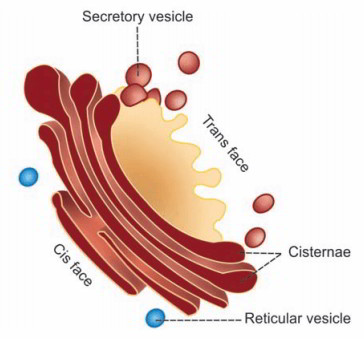The Golgi apparatus is a packaging center
Golgi apparatus or Golgi body or Golgi complex is a membrane-bound organelle, associated with the processing of proteins It exists in all the cells other than red blood cells It is called after the originator Camillo Golgi. Typically, each cell has one Golgi apparatus A few of the cells might have more than one Golgi apparatus Each Golgi apparatus includes 5 to 8 flattened membranous sacs called the cisternae. A single cell might consist of more than one Golgi apparatus, generally situated near the nucleus.
Golgi apparatus is positioned near the nucleus It has 2 ends or faces, particularly cis face and transface The cis face is placed near the endoplasmic reticulum. Reticular vesicles from endoplasmic reticulum get in the Golgi apparatus through cisface The trans face is positioned near the cell membrane. The processed substances make their exit from Golgi apparatus through transface The Golgi apparatus exists in bigger numbers and is best established in cells that produce protein, such as the cells of the salivary glands or the pancreas. The Golgi apparatus functions in association with the endoplasmic reticulum.
Process
- Some proteins and glycoproteins synthesised in the rough endoplasmic reticulum (RER) are provided to the Golgi apparatus by transport vesicles The vesicles normally reach a cisterna called the cis face (” getting’ side).
- Numerous transport vesicles integrate to form cisternae on the cisface Inside the Golgi apparatus, enzymes customize the showing up proteins and glycoproteins. For instance, the enzymes might alter the carbohydrate structure of a glycoprotein, or they might connect a phosphate group, sugar, or fat to a protein.
- More adjustment and packaging happen as the cisternae move to the trans face.
- Little transport vesicles return local Golgi proteins to cisternae of the cis face for reuse.
- Eventually, the product gets to the trans face (” shipping” side), which is generally oriented towards the totally free surface of the cell.
Functions of Golgi Apparatus
- Major functions of Golgi apparatus are processing, packaging, labelling and shipment of proteins and other molecules like lipids to various parts of the cell.
Processing of productsVesicles including glycoproteins and lipids are carried into Golgi apparatus Here, the glycoproteins and lipids are customized and processed.
- Packaging of materials
All the processed products are crammed in the form of secretory granules, secretory vesicles and lysosomes, which are carried either from the cell or to another part of the cell. Since of this, Golgi apparatus is called the ‘ post office of the cell’.
- Labeling and delivery of materials
Lastly, the Golgi apparatus figure out the processed and loaded products and identifies them (such as phosphate group), relying on the chemical content for shipment (circulation) to their correct locations. For this reason, the Golgi apparatus is called ‘ shipping department of the cell’.


 (49 votes, average: 4.55 out of 5)
(49 votes, average: 4.55 out of 5)